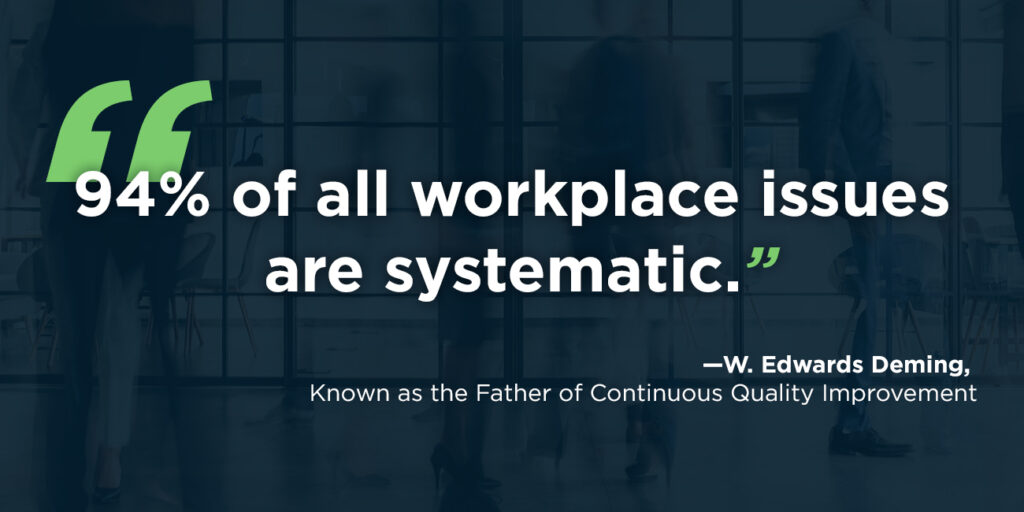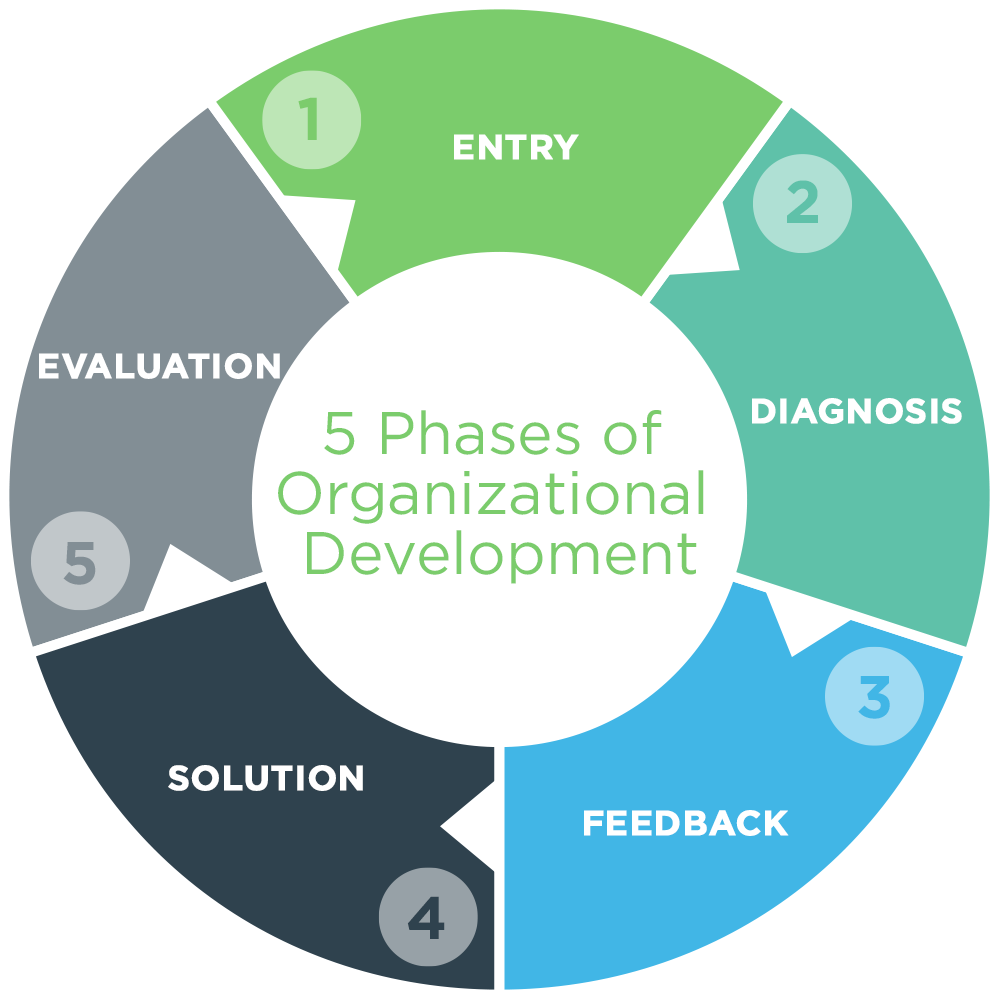Overview
Organizational development (OD) is a collaborative and data-driven process, where an OD professional works with an organization to help it bring about deep, complex, and lasting change.
Organizational development interventions draw from psychology and the social sciences, which examine human behavior, especially how people interact as a group, develop as a culture, and make a collective impact.
People seek organizational development services for various reasons: To increase the organization’s efficiency and effectiveness. To develop leaders. To improve workplace culture. To adapt and thrive in our continually changing world.
How is organizational development different from EAPs?
Organizational development services are designed to address larger systemic issues embedded in the organization itself, such as leadership, culture, structure, and processes.
Employee assistance programs (EAPs) are designed to support the personal needs of employees and their family members, with services that address mental health, financial wellness, and family matters.
Organizational development services can be a perfect enhancement to employee assistance programs by addressing the underlying concerns that may be impacting an organization’s health and culture.
How are OD services different from human resources?
Organizational development services address the organization’s processes, values, and culture. They also impact all levels of the organization: individuals, groups, and leaders.
Human resources, by comparison, focus on the employee experience. Also known as human resource management (HRM), human resources involve recruiting and selecting employees, training and developing employees, implementing policies and compliance, and managing performance, compensation, and benefits.
Why is organizational development important?
During the past several years, many of the world’s social, political, and economic challenges have impacted today’s organizations and workplaces. Today’s business landscape is often characterized by volatility,uncertainty, complexity, and ambiguity.
Organizational development can help organizations adapt and thrive in this challenging environment by helping them strengthen their workplace culture, develop leaders, implement new processes, and provide necessary long-term guidance and support.
Harvard Business Review recently published an article that explains how today’s most common workplace stressors are deeply embedded in an organization’s cultures and processes.
Here are some examples:
- Operational bottlenecks and short-staffing. This often leads to excessive stress, low morale, burnout, and other mental health concerns among employees.
- Lack of diversity. This makes it more challenging for some employees to experience a sense of belonging and inclusion. It can also limit an organization’s perspective and competitiveness.
- Bullying and ineffective leadership. Emotionally unhealthy or toxic work environments can negatively impact employees’ mental health and performance.
While employee assistance programs can help people manage the stress that stems from these scenarios, they are not designed to address these larger, systemic issues that are embedded in the organization itself.
That’s why organizational development services were created — and why they continue to grow in popularity today.

What are the benefits of organizational development?
Organizational development seeks to promote organizational change in a variety of ways.
Different organizational development models help organizations achieve different goals. Here are some examples of different goals and their benefits:
- Improved organizational performance. This may involve creating new interventions to address inefficiencies, streamline processes, and meet new goals, objectives, and interventions.
- Enhanced collaboration and communication. Organizational development interventions work with all levels of the organization to break down silos and promote greater openness among all levels and departments. This often improves decision-making, problem-solving, and other business processes.
- Effective change management. Organizational development initiatives help organizations transition after mergers, acquisitions, and digital transformations. The OD specialist can help navigate change and manage resistance, helping the process move forward smoothly and effectively.
- Greater agility. Organizational development helps individuals and organizations respond effectively to new challenges and opportunities by fostering a culture of continuous improvement.
- Streamlined processes and systems. The “people, process, technology” framework examines an organization’s processes and technologies from the user’s perspective. The process begins with a collaborative data-gathering process. Organizational initiatives are then developed accordingly.
- Clearly defined goals and procedures. When everyone understands an organization’s goals and objectives, it’s easier to drive organizational change.
A brief history of organizational development
Organizational development became known as “the process for change” when social scientists, organizational psychologists, and business-minded scholars began to research and formalize it.
Social psychologist Kurt Lewin was among this group. In the 1940s, he introduced a three-step change management process, using the analogy of a block of ice: If an organization wants to implement change, it must undergo a change process, similar to a block of ice that melts. This process enables the organization to be shaped into a new form, and refrozen to make the changes permanent.
Lewin’s organizational development process emphasized the importance of including organizational members in the change process. The field of organizational development has been evolving ever since and remains a growing and dynamic field:
- In the 1960s, organizational development started to focus on group dynamics, sensitivity training, and experiential learning to strengthen interpersonal skills, teamwork, and organizational effectiveness.
- During the 1970s, organizational development became more formalized. Scholars and practitioners emphasized the importance of data collection, data analysis, and feedback to identify issues and develop interventions. Humanistic psychology also influenced organizational development, by emphasizing the importance of individual growth and self-actualization.
- The 1980s saw a shift toward quality-oriented approaches, such as Total Quality Management, which emphasized customer focus, continuous improvement, leadership development, and employee involvement.
- During the 1990s and 2000s, OD practitioners adopted Systems Thinking and Complexity Theory, which viewed organizations as complex, dynamic systems. They also looked at how elements within the organization could be leveraged to promote change and innovation.
- Since the 2000s, organizational development has been greatly influenced by technology and the rise of virtual work environments. Many OD interventions are now offered virtually, such as online training, virtual team building, and remote coaching.
Types of organizational development interventions
Organizational development interventions typically fall into the following four categories:
- Human process interventions. These interpersonal interventions can take place on various levels. For example, they can be individual interventions, where an employee is coached or mentored. They can be group interventions, such as employee training or change management exercises. Or they can impact the entire organization by introducing a new organizational structure or a new shared vision.
- Technostructural interventions. These interventions involve changes to the organization’s structure and technology. These interventions can be further categorized into organizational design, total quality management, and work design.
- Human resource management (HRM) interventions. These interventions pertain to employee engagement, experience, and performance management. These processes may involve performance management, wellness interventions, and DEI initiatives.
- Strategic change interventions. These initiatives require behavioral change at all levels of the organization, often due to a merger, acquisition, or downsizing.
5 phases of the organizational development process
Today, most organizational development processes follow a series of phases, similar to those outlined here:

- Entry: The OD consultant and client begin by defining and addressing the root problem. After considering potential solutions, they outline a plan that discusses expectations, a timeline, a budget, tools, and resources.
- Diagnosis: The OD professional works closely with the organization to gather, review and analyze data. What does the organization hope to accomplish or change? What tools or resources will be used to achieve those goals? What barriers stand in the way? How will progress be measured?
- Feedback: Is the organization ready, willing, and able to begin the change process? Analyzing an organization’s capacity for change before a project begins can help the OD practitioner determine where to start and which interventions to use. This phase should also include a communications plan for introducing the process, building awareness and engagement, and gathering feedback.
- Solutions: How will change be implemented? To be successful, the OD practitioner must recruit support from individuals or groups from within the organization who can influence others and promote buy-in. They will serve as role models for others to emulate.In addition, the OD practitioner must determine whether their personal experience and skill set is a good match for the organization. Or, should they refer the project to another OD specialist who is better suited to address the organization’s needs?
- Evaluation: Different goals require different approaches and resources. Are your initiatives achieving the desired goals? Supporting people during the transition with mentoring, coaching, and training is important. Ongoing communication and feedback are also necessary.
Be aware of common challenges
Organizational change requires careful planning and ongoing management. Despite the best of intentions, not all projects go exactly as planned. It’s helpful to be aware of potential obstacles–and have a plan of action for overcoming them. Here are some examples:
- Resistance to change: It’s common for people to resist change when it involves job security, loss of control, disruptions to routines and processes, and a general fear of the unknown. It’s helpful to address each individual’s concerns and anxieties with open and ongoing communication.
- Lack of leadership support. If leaders are not actively involved in promoting the change, employees are likely to become skeptical. It helps when leaders provide a clear vision and allocate resources to support the change effort.
- Inadequate communication: Poor communication can interfere with progress. To build enthusiasm and buy-in, it’s important to discuss the reasons for the change, its impact, and the desired outcomes.
- Unclear objectives and planning. When people are aware of the goals and the strategy for achieving them, it’s easier to implement the change process. When people have a well-defined plan and a roadmap, it’s easier for them to make progress.
- Lack of employee involvement. To foster employees’ commitment to the change process, it helps to seek their input and involve them in the decision-making process.
- Organizational culture and structure. In some cases, an organization’s culture and structure can act as barriers to change. For change to occur, It’s helpful to align the change process with the organizational culture.
- Lack of resources and skills. What will it take to implement the change? Organizations need to provide the necessary training and development opportunities to ensure that employees have the skills and capabilities to adapt to change.
- Overcoming past failures. It’s important to learn from past failures and move forward. However, people can be skeptical. To build trust, it’s important to address people’s concerns and demonstrate how the current change effort is different.
- External factors. We live in a world of flux. Economic conditions, industry disruptions, and regulatory changes can interfere with organizational development. Adapting to these challenges requires agility, planning, and the ability to anticipate and respond to market dynamics.
Navigating these challenges requires a thoughtful and comprehensive change management strategy–that proactively considers these common challenges.
Skills needed in an organizational development specialist
OD professionals need to have excellent interpersonal and project management skills, and the following competencies:
- Ability to diagnose and assess. Once an area of change is identified, the OD practitioner must know how to address and treat the source of the problem and outline a plan of action.
- Analytical skills. Organizational development is a process that begins with an understanding of the organization’s pain points. What data will be used to assess and monitor progress?
- Organizational knowledge. The OD practitioner should also have a deep understanding of the organization’s past and present; its successes and failures, and its competitors and partners. They should also have a deep understanding of the organization’s mission, vision, values, and culture.
- Process skills. Planned change begins with an understanding of the end goals. An OD consultant should outline an action plan and timeline for achieving your desired goals.
- Flexibility. In some cases, the results may show that a plan of action isn’t producing the desired results. When this occurs, a skilled OD professional knows how to pivot. The organizational development process may not require a full redesign, but it could mean reevaluating and tweaking part of the process.
- People skills. To inspire change, an OD professional must be able to gain the trust and support of all those directly and indirectly affected by the change. They need a multi-faceted skillset that is part manager, part cheerleader, and part organizational psychologist.
- Communication skills. The organizational development practitioner must be a skilled communicator, who can explain their recommendations and assessments to the clients.
- Inner strength. Change is frequently fraught with resistance. OD professionals must realize that resistance is part of the process. They must have confidence in their knowledge and skills to follow and trust the process.
The AllOne Health difference
With over 50 years of experience, AllOne Health is the premier provider of whole health solutions for organizations worldwide. Our solutions include reimagined employee assistance programs, organizational development services, crisis management, wellness, and concierge.
Our organizational development services are designed to enhance company culture, develop leaders, and help organizations elevate their people, performance, and potential.
Our goal is to develop healthy, high-performing, and self-renewing organizations that can manage change at all levels of the organization.
Our organizational development team
Our AllOne Health, our organizational development team includes a dynamic group of professionals with extensive experience in human resource management, management consulting, human behavior, and coaching.
This broad perspective and collective expertise allow the team to take a holistic, collaborative, and data-driven approach that uses business and behavioral insights to help our clients adapt and thrive in today’s competitive landscape.
Our services
Our organizational development services are generally focused on helping our client organizations become more efficient and effective or helping them create a healthier workplace culture or environment.
Services are customized to meet the unique goals, priorities, and challenges of each client. Here is a summary menu of our organizational development services, and what these services are likely to accomplish:
- Leadership & Management Development. This service can help strengthen your organization by providing leadership coaching. and training. These services help high-value talent improve communication skills, leadership skills, and decision-making. An individualized coaching plan helps the organization identify goals and develop an action plan.
- Diversity, Equity, and Inclusion. Our DEI consulting services use a systematic approach to help organizations foster a more diverse, equitable, and inclusive environment by embedding these qualities across all departments and organizational levelIndividualsals and teams must work interdependently and cooperatively to improve team rapport and share a renewed sense of purpose and enthusiasm in reaching new goals.
- Group Work & Team Development. How do you get many individuals working together in a productive and unified team? Our group work and team development services range from three-hour team-building sessions to full-day, offsite retreats. The goals are to create improved team rapport, a renewed sense of purpose, and a shared enthusiasm for achieving mutual goals.
- Change Management. Today’s organizations need to respond and adapt to our quickly changing world, which is influenced by today’s political, social, and economic challenges–on continuous technological advancements. Our organizational interventions are designed to help organizations respond to internal and external challenges by designing, developing, and implementing a change management plan.
- Organizational Health & Effectiveness. Effective organizational development processes target and address the root of a problem. Once the cause of the problem is identified, organizational development begins the change process by identifying appropriate strategies and implementing the necessary adjustments to bring about the desired change–whether that’s transforming an organization’s culture or helping it align leadership and teams to improve results and effectiveness across the organization.
At AllOne Health, our recent expansion has helped us augment our organizational development services, expertise, and reach. Today, our team includes OD professionals from eight different AllOne Health subsidiaries, including:
- ERS EAP in Chicago, IL
- Ease@Work in Cleveland, OH
- Impact Solutions in Cleveland, OH
- Lytle EAP Partners in Pittsburgh, PA
- AllOne Health in Natick, MA
- FEI Behavioral Health, in Milwaukee, WI
How to get started
It all begins with a conversation. If you are new to AllOne Health, we encourage you to request a quote. If your organization already has an AllOne Health employee assistance program or wellness services, contact your account manager, who can help you schedule a meeting with an OD consultant.
With over 50 years of experience, AllOne Health covers more than 6 million lives across thousands of organizations worldwide. Our fully integrated whole health solutions include employee assistance programs, wellness, concierge, organizational development, and crisis management.


